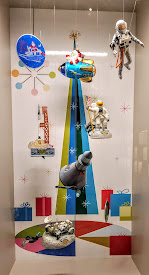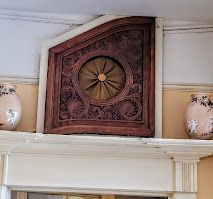Our drive from Lake Martin took us up to Huntsville, where we parked ourselves at Redstone Arsenal.
The sites were spacious, and trees were not a concern. During our stay they were working on an area in the trees that will contain about 15 sites in the trees. The campground has some nice walking/biking paths around it, and I tried as many as possible.
Close to Redstone Arsenal is the Space and Rocket Center. The website is: http://www.rocketcenter.com.
The center is broken into several buildings and an outside exhibit. After buying our way in, the first area is an omage to the toys of space.
Bet some of you didn't know Barbie was an astronaut. It is kind of funny the Ken did not qualify for the space program. In case you may not be able to see the date on the box, it is dated 1965.
G.I. Joe also got his opportunity to explore space. The capsule must have been a convertible, looking at how his helmet sticks out of the capsule.
The Cabbage Patch Kids were not going to be left out from venturing to space.
There were many more dolls made to accommodate the new frontier of space, and you will just have to visit the center to see them yourselves.
What is a holiday without your very own Christmas ornament for the tree.
The next area is where the American space program began, with a 15 year old boy, named Wernher Von Braun.
Here is a display of his early renditions of space travel... and from here is history. For those that cannot read German, the upper page reads as follows: SUPPLIES to be taken along: photographic equipment, food for 100 hours, anti-glare glasses of varying intensity, divers suit with heating and cooling system, oxygen for 120 hours, spare window and bulbs, signaling equipment, tools, astronomical telescope, radio equipment, rock samples, and test equipment. Wernher was definitely a thinker at an early age. More about Von Braun later.You're looking at the various suits our astronauts wore during the early days of the space program, up to today. The suit on the right is the Shuttle Ejection Escape Suit. This suit was used by the first shuttle mission. The next suit is the A7L Apollo Commander Suit. The suit was designed for moon missions, and were specially made for each individual. Second from the left is the Gemini Spacesuit. This suit was tested by the Air Force, and worn for many NASA milestones, including the first multi-crew, first extravehicular activity or spacewalk, and first rendezvous and docking by two spacecraft. Far left suit is the Mercury Suit. The suit was originally designed by the U.S. Navy for high altitude flying.
One has to understand that Redstone Arsenal played a big part in the space program, but it was originally an Army facility, that is why this museum is located here in Huntsville. Let's continue our travels through the center.
The next section provides a look into the progression of some of the missiles our militaries use.
The bottom missile is the Longbow Hellfire. This is a helicopter launched, fire-and-forget missile. This weapon was used against anti-armor vehicles, enemy air-defense, and threat helicopters. The next two are the Hydra 70 2.75" Rocket. This rocket was either rotary or fixed-wing launch, playing an air-to-ground role. It was used against anti-personnel/material, suppression of threat assets, smoke, and illumination. The rocket was used as late as Afghanistan and Iraq.How about a couple of challenge questions?
Q1: which U.S. Army missile defense system uses NASCAR technology to enhance soldier performance?
A: Thermal High Altitude Area Defense (THAAD).
Q2: what is the common theme among U.S. Army helicopters?
A: they are all named after Native American Indian Nations.
Moving on we came to an interactive shuttle exhibit.
Here we had the opportunity to land the space shuttle... Carol did a better job than I did... maybe its time for her to take over driving the rig.
I was really amazed at how the shuttle and rocket travel to the
launch pad. The assembly traveled the 3.4 miles, at a speed of .8 MPH, secured to the Mobile Launch Platform with eight of the bolts to the left. There was a nut on each side of the bolt. The upper bolt had an explosion pack on it for splitting the nut in half at launch. Keep in mind, the shuttle leaves the platform, reaching a speed of 18,000 MPH, in 8 minutes.In space is a whole different world. How many of you like spaghetti w/meat sauce... enjoy. Freeze-dried at its finest.
There are a lot of areas that we regular humanoids would have to come to grips with. One such area is taking care of personal bodily functions, another is the opportunity for exercise while on the International Space Station (ISS).
Remember I mentioned personal business... this is the Urine Processor Assembly rack. If you should be wondering what is done with the urine... well... it is recycled into potable water, used in food preparation, and for hygiene purposes.
I promised you exercise on the ISS... by way of the treadmill. If I was looking at it right, joggers are running uphill. NASA has a requirement that astronauts exercise two hours a day. You might also notice that the astronaut must be harnessed in, otherwise they would float away.

Leaving the International Space Station exhibit, we headed outside. Before we get outside, lets look at a training tank.This tank is filled with water, simulating the weightlessness of space. If you go on the center's website, you will notice that space camp attendees also train in this tank.
This is as close as Carol and I will ever get to the astronaut program. This suit is in the entry way to our next building.
This was the culmination of his efforts up to 1932. Thanks to Hitler, Mr. Von Braun was forced to set aside his dreams of space travel, so that Germany could concentrate on building V-2 missiles for bombing England. If you are asking yourself how Mr. Von Braun worked our space program, it had to due with the advancement of American forces into Germany. Several rocketeers besides Mr. Von Braun surrendered to the American forces, and began developing missiles for the United States.

This was the memory for the Saturn rocket. What you are actually looking at is one of fourteen planes that made up a Launch Vehicle Digital Computer (LVDC). The fourteen stacked planes made up the memory module. These planes were hand woven by technicians. Each one of those planes contained 8,192 ferrite cores (beads), equaling 1 bit of information per core. Depending on how the core was woven in, it would be either a 1 or 0 bit of information. One memory module equaled 114,688 bits. Depending on the mission, they could add additional memory modules.

The astronauts options were sitting (center of photo), or lying down (right side of photo). It wasn't a piece of cake getting through the Earth's atmosphere either, the module lost some of its heat shield, needless to say, it didn't go on any other mission.
Dr. Burritt was born in Huntsville in 1869, becoming a homeopathic doctor. The doctor married, later losing his wife due to complications from surgery. His second marriage was to a wealthy St. Louis woman, they remained in St. Louis, where he redirected his attention from medicine to rubber manufacturing.In 1933 his second wife died and he inherited a good portion of her wealth, and he returned to Huntsville.
Dr. Burritt was a man who liked things different, and it showed in items in the home. The fireplace hearth in the dining room is one example. The photo at the right is a speaker cover.
The village includes a school, church, store, and a blacksmith's shop; all the buildings were built in the mid to late 1800s.
























































No comments:
Post a Comment